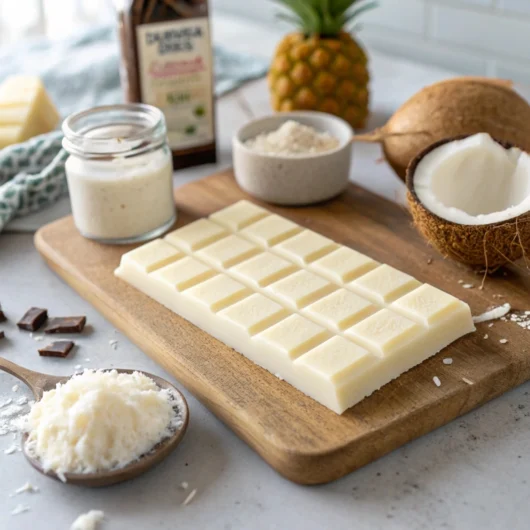Vegan Sugar-Free White chocolate is tempting with its creamy texture that melts on your tongue. But you can make it without cow’s milk by using plant-based ingredients. Gather key ingredients for a tasty, dairy-free snack with no added sugars. Take your time! You can enjoy a snack that bakes to perfection or meets your cravings.
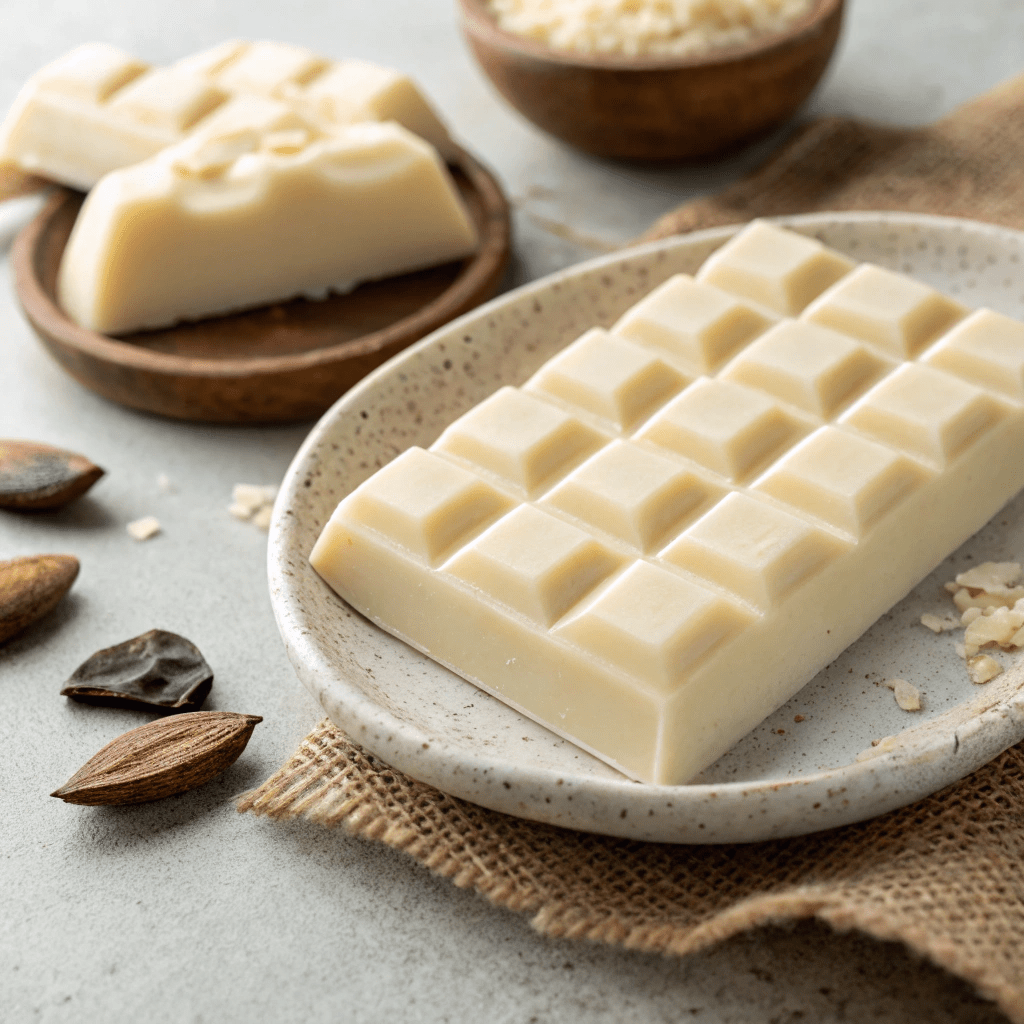
This guide will help you master a vegan version of white chocolate. You’ll learn to choose the best ingredients and create that smooth taste you love.
My Sugar-Free White Chocolate Explorations
My first foray into sugar-free white chocolate recipes was a bit of a hit-and-miss affair. I underwent some trials. I struggled with gritty textures, uneven sweetness, and chocolate that wouldn’t set. After much trial and error, I found the best way and ingredients. Now, I can make creamy, delicious white chocolate with little effort.
This brings me here to share that perfect recipe and how to avoid the traps we all tend to fall into. Look for white chocolate bars that are dairy-free and sugar-free. They should also have the creamy taste of traditional white chocolate!
Step-by-Step Vegan Sugar-Free White Chocolate Recipe
Vegan Sugar-Free White Chocolate
Course: DessertCuisine: American, British10
servings20
minutes100
kcal20
minutesCreamy, dreamy vegan white chocolate with zero added sugar! Crafted with rich cacao butter and coconut milk, this melt-in-your-mouth treat is endlessly customizable with zesty, fruity, or minty twists. It’s quick to make yet luxuriously smooth.
Ingredients
100 g raw cacao butter (melted)
2 tbsp powdered coconut milk
Add 2 tbsp of powdered sweetener, and we recommend using erythritol or monk fruit
1 tsp vanilla extract
Pinch of salt
Optional add-ins: freeze-dried berry powders, cashew butter, or peppermint extract.
Instructions
- Place cocoa therapy in a double boiler to melt over low heat. Set a heatproof bowl over a saucepan with two simmering cups of water. Do not let your chocolate get too hot, nor spray water, as this will affect its mouthfeel.
- Once you melt the cacao butter, please remove it from the heat. Next, mix in powdered coconut milk, sweetener, vanilla extract, and a little salt. Blend or whisk the ingredients until smooth. You can use an immersion blender or a hand whisk. This keeps the granules away and lends the chocolate a buttery mouthfeel.
- Pour the chocolate liquid into your favourite moulds. Tap the mould against a counter with a soft touch to dislodge air bubbles. Let the chocolate cool for 10 to 12 minutes. Then, put it in the fridge for 20 to 30 minutes until it is completely set.
- Mix in flavours like orange zest, peppermint extract, or freeze-dried fruit powders. Do this before pouring the melted mixture into moulds. This way, you can customize your chocolate.
- Melt and mix your cacao butter with the powdered sweetener. This step ensures everything combines well for a silky finish. Sifting your dry ingredients into the liquid mixture is best to prevent graininess.
Recipe Video
Notes
- Ensure all utensils are completely dry to prevent chocolate from seizing. For optimal texture, sift powdered ingredients and store chocolates refrigerated in an airtight container.
Ingredients:
- 100 g raw cacao butter (melted)
- 2 tbsp powdered coconut milk
- Add 2 tbsp of powdered sweetener, and we recommend using erythritol or monk fruit.
- 1 tsp vanilla extract
- Pinch of salt
- Optional add-ins: freeze-dried berry powders, cashew butter, or peppermint extract.
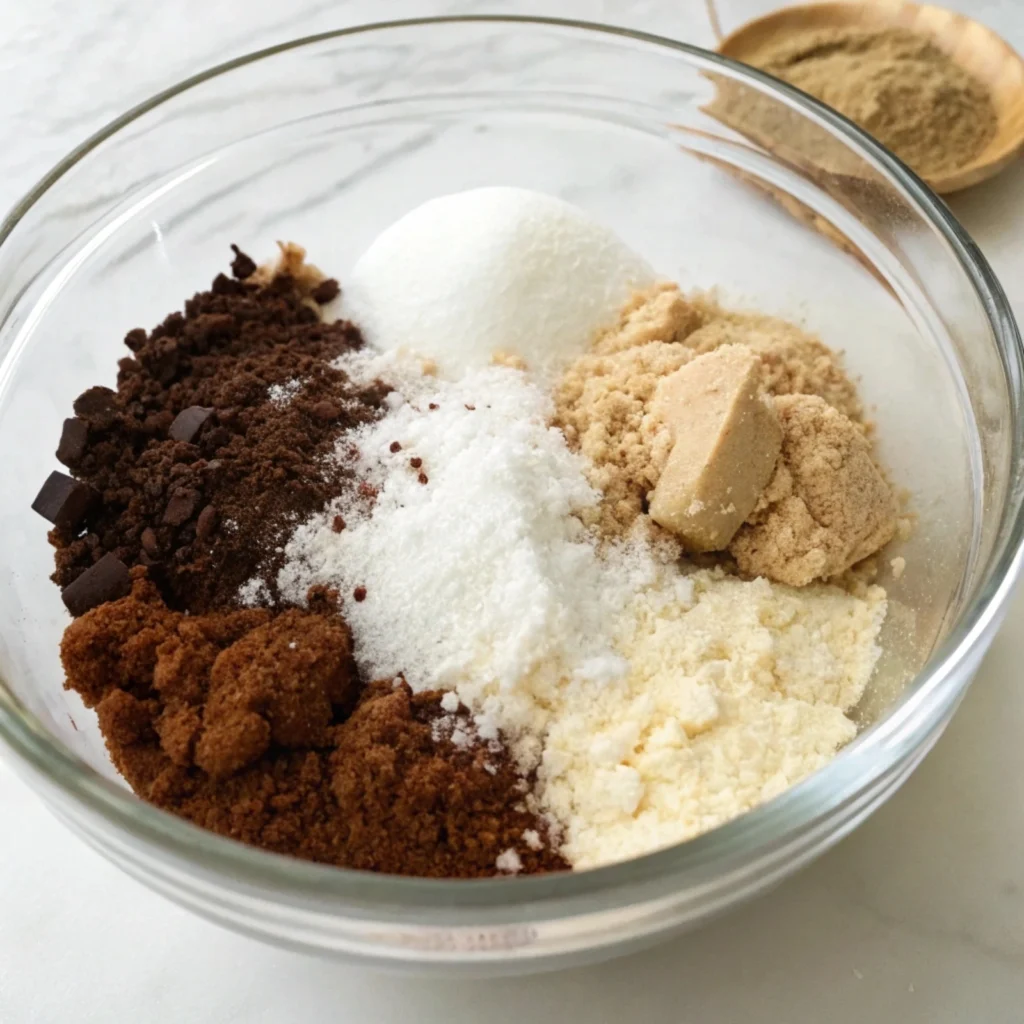
Instructions:
Place cocoa therapy in a double boiler to melt over low heat. Set a heatproof bowl over a saucepan with two simmering cups of water. Do not let your chocolate get too hot, nor spray water, as this will affect its mouthfeel.
Blend the ingredients for a smooth consistency.
Once you melt the cacao butter, please remove it from the heat. Next, mix in powdered coconut milk, sweetener, vanilla extract, and a little salt. Blend or whisk the ingredients until smooth. You can use an immersion blender or a hand whisk. This keeps the granules away and lends the chocolate a buttery mouthfeel.
How to Set the Chocolate After Pouring It
Pour the chocolate liquid into your favourite moulds. Tap the mould against a counter with a soft touch to dislodge air bubbles. Let the chocolate cool for 10 to 12 minutes. Then, put it in the fridge for 20 to 30 minutes until it is completely set.
Infusing with Unique Flavors
Mix in flavours like orange zest, peppermint extract, or freeze-dried fruit powders. Do this before pouring the melted mixture into moulds. This way, you can customize your chocolate.
Avoiding Common Mistakes
Melt and mix your cacao butter with the powdered sweetener. This step ensures everything combines well for a silky finish. Sifting your dry ingredients into the liquid mixture is best to prevent graininess.
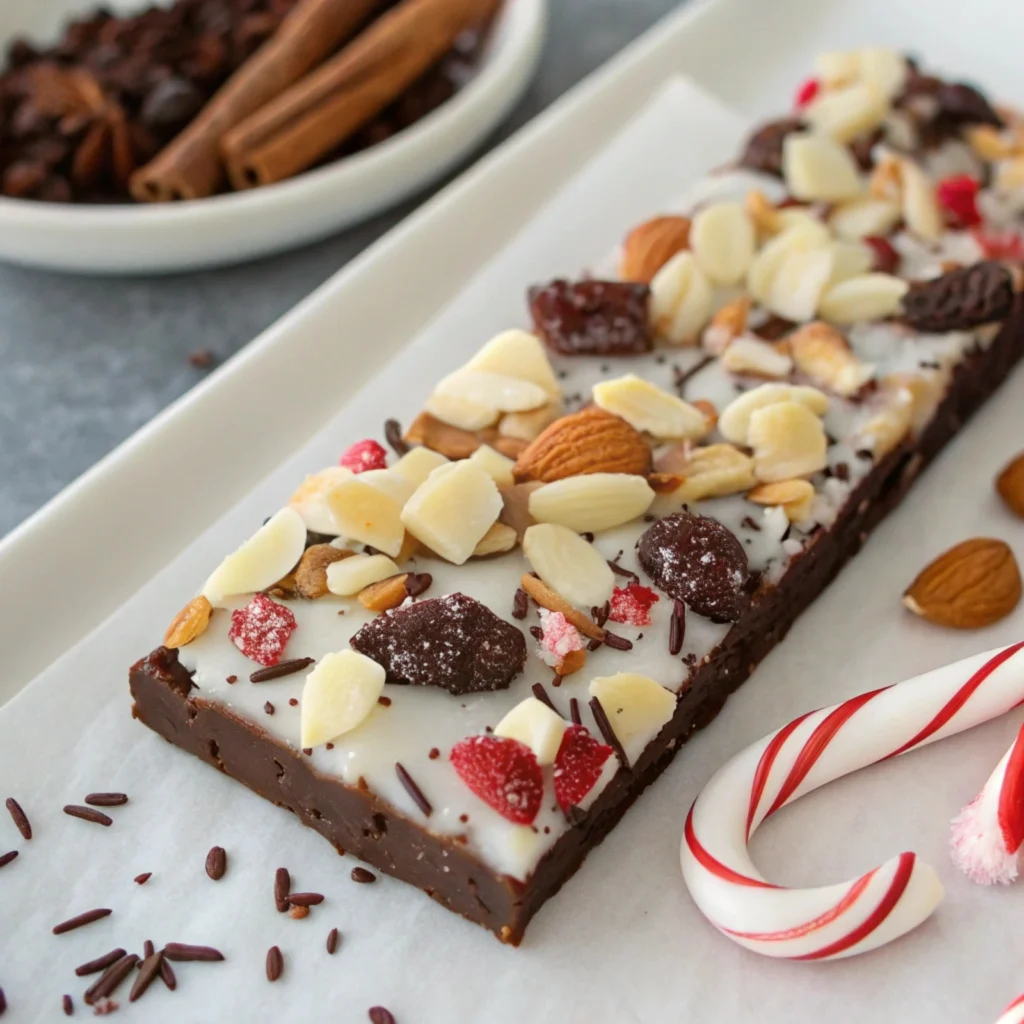
Suggested Toppings and Decorations
Get creative with your bars! Top with:
- Crushed nuts (almonds, macadamias)
- Dried fruit pieces
- Cacao nibs for a crunchy bite.
- Coconut flakes or candy cane pieces for a festive flair.
Nutrition Information
Here’s a quick overview of the nutrition for one serving of this sugar-free white chocolate from the recipe:
- Calories (per 2.5-inch square): ~100
- Fats (grams): 8
- Net Carbs (grams): 2
- Sugars (grams): 0
Tools to Make Sugar-Free White Chocolate
Here’s what you’ll need to get started:
- Double boiler, heatproof, and saucepan.
- Immersion blender for smooth blending.
- Moulds for chocolate bars, silicone moulds, or chocolate chip moulds.
- For scraping, use a silicone spatula.
- Candy thermometer (optional, but helpful for tempering).
- An airtight container for storage.
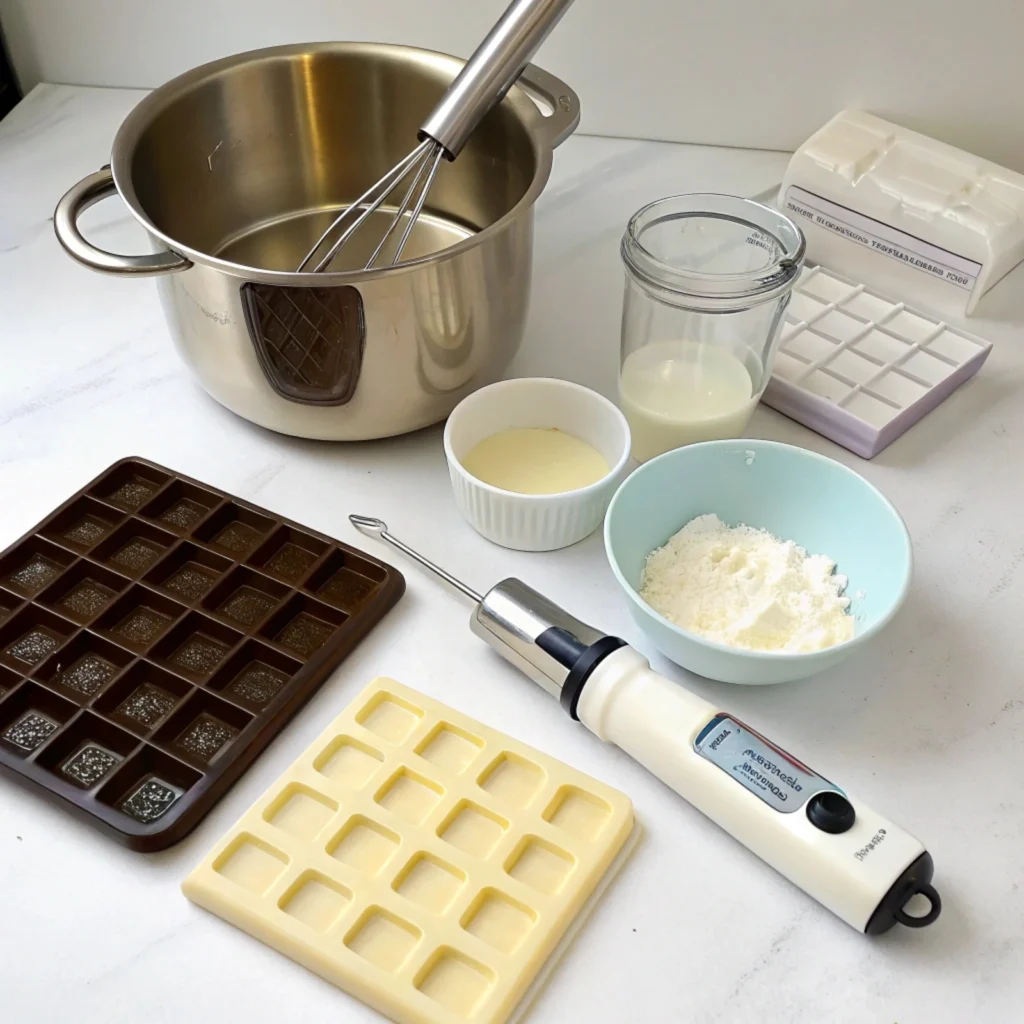
Storage Tips for Homemade White Chocolate
After the chocolate has completely set, transfer it to an airtight container. This keeps it fresh. Keep the container cool and dry, away from direct sunlight and heat. Such factors are detrimental to the chocolate’s texture and flavour. Put the chocolate in the refrigerator if you are in a warm climate. This also makes it firm and does not let it melt.
Place parchment paper between the layers to prevent the pieces from sticking when stacking. Store your sugar-free white chocolate in a cool, dry place. It will stay fresh for two weeks. It’s perfect to have on hand for snacking or gifting!
Variations to Suit Different Diets
- Keto-Friendly Adjustments:
Swap coconut milk powder with keto-approved heavy cream or dry milk powder.
- Gluten-Free Options:
This recipe does not contain gluten. Ensure that you certify all ingredients are gluten-free if required.
- Nut-Free Version:
Omit cashew butter and opt for sunflower lecithin instead!
FAQs about vegan sugar-free white chocolate
Is it possible to make this recipe nut-free?
Yes, it can! Leave out any optional nut butter from the ingredient list. Use sunflower lecithin instead. It keeps the creaminess and makes it nut-free. It is also friendly for people with allergies.
How long does white chocolate last at home?
Homemade white chocolate stays fresh for up to 2 weeks. Please keep it in an airtight container in a cool, dry place. Refrigerate in a warm climate; it will melt. Wrap it securely to prevent it from absorbing the smell.
Can I use liquid sweeteners in place of powdered ones?
Fluids: This impacts texture. You can use liquid sweeteners (e.g., honey or maple syrup) to soften or destabilize the chocolate. Use powdered sweeteners, like powdered sugar or monk fruit, for the best results. But they work better together and keep the cocoa solid.
So, do you need a candy thermometer like this?
You don’t need a candy thermometer, but I strongly recommend using one. This raises the temperature of the chocolate to achieve the proper tempering, which results in a silky, smooth, shiny finish and a professional texture.
Is this chocolate appropriate for baking?
Absolutely!
To bake with white chocolate:
Mix it into white chocolate macadamia nut cookies.
Melt it in hot chocolate.
Drizzle it on cakes and pastries.
Use it for a decadent touch.
Why is my chocolate grainy?
Graininess can occur with sweeteners or powders that aren’t completely dissolved. To prevent this, mix and melt all the ingredients well. Powdered sweeteners are also beneficial for smoothing texture.
Is coconut oil a good substitute for cacao butter?
Cacao butter uniquely provides the texture and flavour of real white chocolate. Coconut oil doesn’t work as a substitute for white chocolate. It lacks the right properties. Actual white chocolate needs the proper amount of firmness and snap.
Q: How do I get my texture sounds with a snap?
To achieve that signature snap, you need to temper the chocolate. The last step is tempering. This process stabilizes the cocoa butter crystals and gives the chocolate a hard, shiny surface. Finally, for the sake of texture, put the chocolate in a calm, dry environment.
Why You’ll Fall in Love with Homemade White Chocolate
Vegan craft, sugar-free white chocolate brings a feeling of satisfaction. They review the ingredients to create a healthier treat. Every bite is full of love, care, and creativity. You can enjoy this snack, mix it with white chocolate biscuits, or give it as a homemade gift. This recipe is my absolute favourite.


